People come from around the world to visit The Polynesian Cultural Center (PCC) where they can immerse themselves in 6 amazing island cultures, Hawaii, Aotearoa, Fiji, Samoa, Tahiti and Tonga. Each ‘village’ provides in-depth experiences in history, culture, music, dance and activities. Its a wonderful, full-day experience.
One of our signature sights as our guests travel through the Center is of 5 statues, placed on a small island in the middle of our lagoon….tall figures, strange hats. Rather quiet and mysterious.
They are called Moai, and they are handmade authentic replicas of the statues found on the 64 square mile island of Rapa Nui, on the eastern most point of the Polynesian Triangle. You may know it by its European name of Easter Island. Four native carvers from Rapa Nui honored the PCC in 2003 by traveling here to Oahu to build these sacred figures, literally from the ground up.
Rapa Nui’s Moai Statues
Since they came to the attention of the outside world, the moai of Rapa Nui have captured the fascination of everyone who sees them. The original stone statues range from just a few feet high to almost 80 feet high and are made from scoria — or hardened volcanic ash. As you can see, they sit on top of ahu platforms which cover ancestral burial sites.
Unfortunately, scoria is not very durable, and ongoing conservation of the existing moai is a major concern. In all, the islanders created almost 900 statues, although the majority of those were never transported or erected on ahu platforms. Most were not even finished.
Many theories have been put forth about why they were carved and how people without sophisticated machinery could move the heavy megaliths. One island tradition says those moai that were eventually set up on ahu platforms facing the ocean “walked” there. Those with more of an engineering orientation say this is in actuality, feasible. They theorize that people may have used a series of long ropes and log rollers to tip a moai a little toward one side. They would then pivot the statue forward on the resting point, much as one person moves a heavy object by rocking it forward without having to pick it up.
Their crowning glory is hair, not hats
Most of the islanders, including the four carvers who came to the Polynesian Cultural Center, believe that the moai represent their ancestors. They point to the fact that no two moai are carved the same. The carvers also believe the capstones, usually made from reddish scoria rock, represent their ancestors’ hair or top-knots.
Asked why one of the moai at the Cultural Center’s Ahu Tu’u Koihu doesn’t have “hair,” the lead carver responded, “he was bald.”
Moai eyes truly are the window to their souls
The carvers of the PCC Moai shared how they each dived into the ocean around their island and brought pieces of white coral and dark scoria with them to Hawai’i to make the “eyes” for the moai. After they placed these eyes into the sockets they had carved, the moai were no longer “blind,” but now “could see. The eyes give life to the moai and, therefore, to the people who were [traditionally] buried under the ahu.”
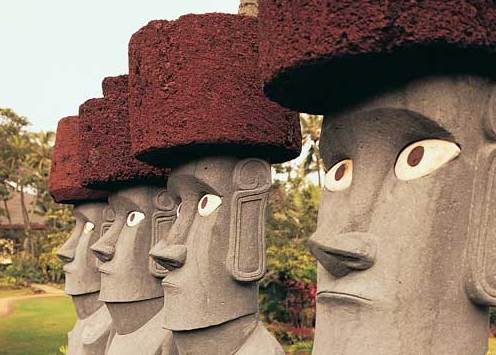
A close-up of the scoia top knot and white coral eyes of the PCC moai
Origins of the carvings
The carvers also explained that moai were erected on an ahu platform, which is where their ancient ancestors buried their ariki or high chiefs. “Today, we interpret these moai as sculptures of particular ariki who were buried in this ahu. In the Rapa Nui culture when a high chief passed away, the family would make a moai representing the person buried in the ahu.”
Finally, the four carvers said, “Although this ahu is a partial replica of Ahu Nau Nau in Rapa Nui, we have chosen to give it the name Ahu Tu’u Koihu. Tu’u Koihu was an ancient ariki from Rapa Nui who initiated the art of carving moai.”
Why isn’t there a Rapa Nui village?
One of the main purposes of the PCC is to preserve and promote the unique cultures of Polynesia. We are proud to provide our guests not only with solid historical information, but the beauty and culture of our various islands through dance, demonstrations and interaction. As part of that goal, each island “village” is staffed with villagers from that nation.
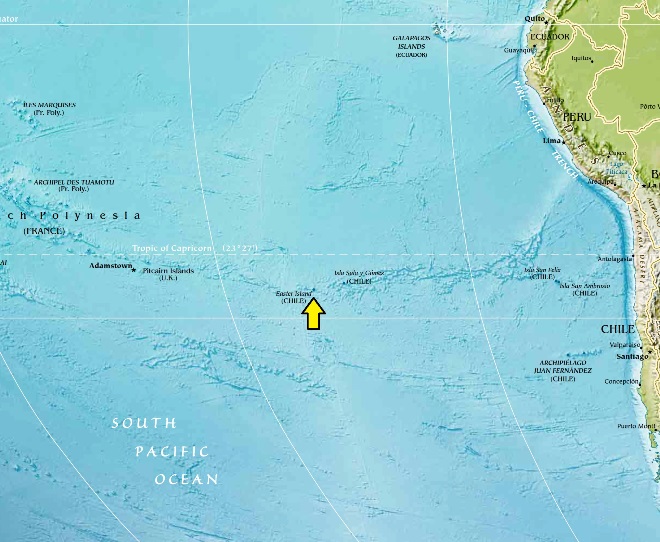
Map of Rapa Nui off the coast of Chile courtesy of the University of Texas – Austin
Sadly, the vibrant population of long-ago Rapa Nui, along with their traditions and history have experienced difficulties, Archaeologists and historians were challenged to answer the mystery of what happened to the people of Rapa Nui island. The shocking answer appears to be that much of the population died out from starvation, disease and exposure. Rapa Nui is 2,400 miles off of the South American coastline and far from the standard trade routes of the Polynesian islands. Such isolation meant that the inhabitants needed to survive off of their own resources. Overpopulation and the complete depletion of both food and building materials, along with a violent civil war caused a mass decline of the local population.
The final blow came in the late 1700’s when European explorers arrived, bringing with them disease. Eventually settlers with livestock settled on the island, finalizing the transformation of the once verdant, tree laden island into a barren grassland. By 1877, the population had dwindled to only 111 resulting in the tragic loss of much of their history, songs, dances and traditions. Current estimates according to a number of sites estimates approximately 2,000 to 3,000 individuals self-identify themselves as descendants of the people of Rapa Nui.
The Polynesian Cultural Center is proud to share the island culture of Rapa Nui with our visitors and friends. We hope when you come to the Center that you take the time to visit the moai and learn more about this mysterious, fascinating island culture.
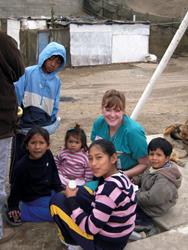
Nina S Jones
Nina Jones, a mainland gal from way back, is now a transplanted Islander. With her husband of 40+ years, she volunteers at the Polynesian Cultural Center. Her hobbies include swimming, traveling, studying and writing about what she is learning from the various Polynesian cultures. Her blogs focus on their history, beliefs, practices and – as an added bonus – delicious food! To her, Polynesia is not just a place to visit, it is a way to live and she is very honored to be able to be a part of this amazing world.

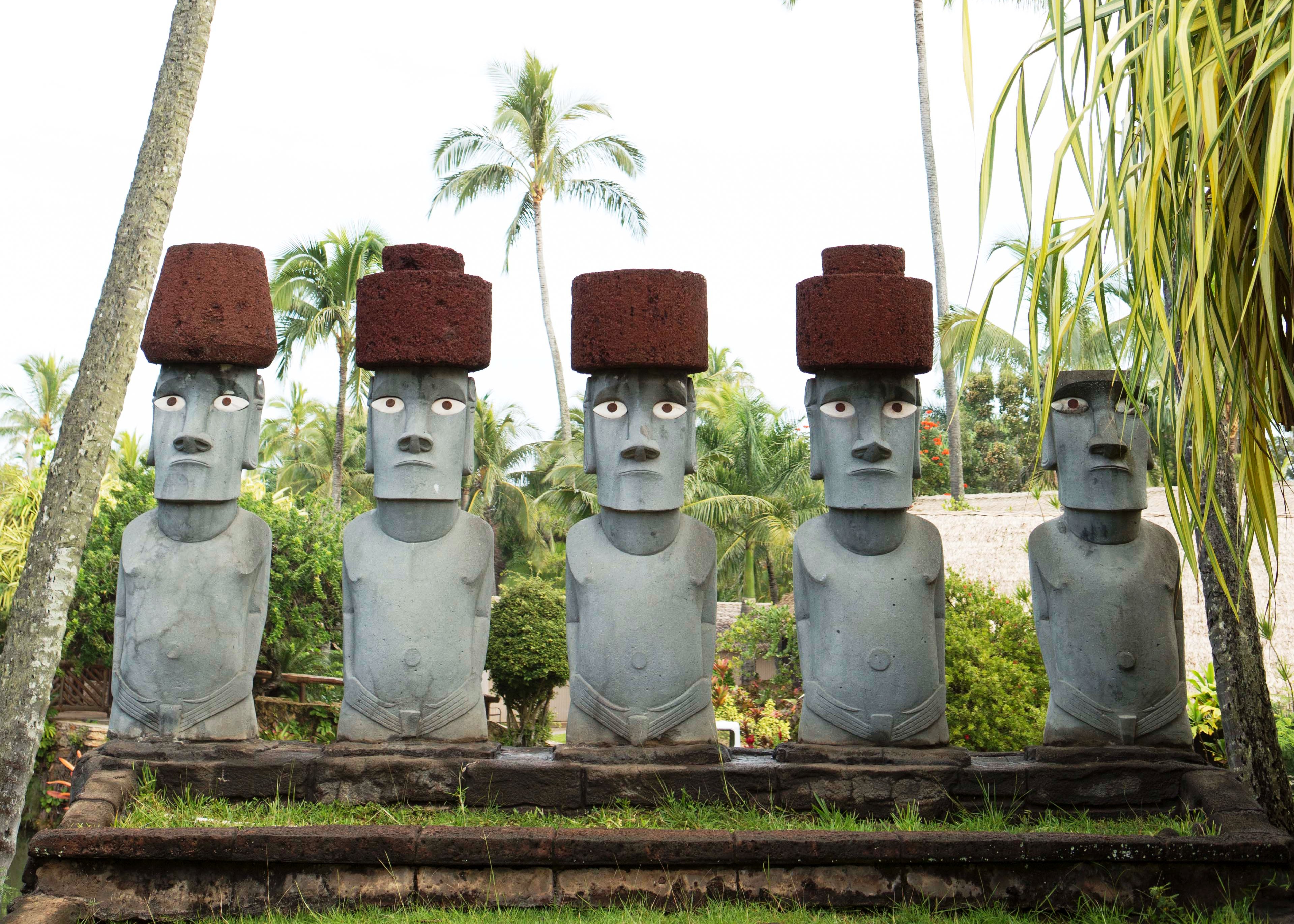
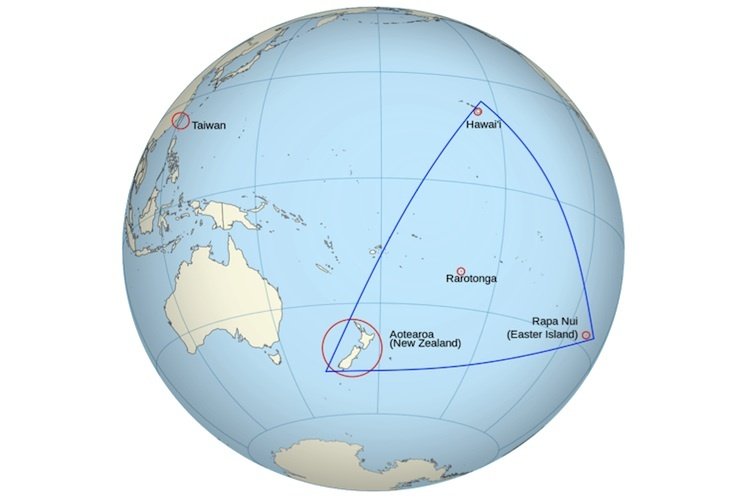
How interesting! Thanks for sharing! Hope to be able to visit there one day soon!
Mahalo for the well written article Nina.
My husband and I visited Hawaii and the PCC in 2010. The PCC was just incredible and we enjoyed it very much. Hope to someday go back.
We look forward to welcoming you back again.
Rapa Nui very much do exist still and it’s extremely important to not spread the myth of our extinction, especially for a center that aims to ‘preserve’ Polynesian culture.
We greatly appreciate you pointing out this issue. Your comments certainly highlights the lack of accurate information on the Internet. We have changed the wording in our article to better reflect the presence of your culture in today’s world. We have much to learn from you, and we look forward to the opportunity to see more regarding your culture’s story both from the past and present. In fact, if you have the interest and opportunity to submit an article clarifying the cultural lives of Rapa Nui descendants, we’d love to consider publishing it here. You will receive an email with further details. Mahalo.